Chapter 6: Population and Demographics
Introduction
An analysis of population demographics is a fundamental element of any comprehensive plan. To understand the Town’s current and future needs, a detailed examination of community characteristics will help decisionmakers understand the impacts of population patterns on public facilities and services by:
- DescribingOgunquit’s recent population trends;
- Discussinghow these trends relate to and contrast with those in neighboring communities, York County, and the State at large; and
- Describingkey characteristics of the current Ogunquit
Overview
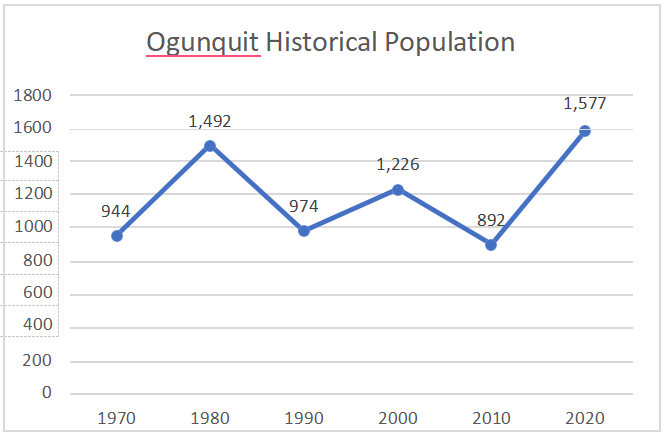
| Population Change, 2000-2020 | |||||
| 2000 | 2010 | 2000- 2010 | 2020 | 2010- 2020 | |
| Ogunquit | 1,226 | 892 | -37.4% | 1,577 | 43.4% |
| York | 12,854 | 12,529 | -2.6% | 13,723 | 8.7% |
| Wells | 9,400 | 9,589 | 2.0% | 11,314 | 15.2% |
| Maine | 1,274,923 | 1,328,361 | 4.0% | 1,362,359 | 2.5% |
| York County | 186,742 | 197,131 | 5.3% | 211,972 | 7.0% |
| Source: US Decennial Census | |||||
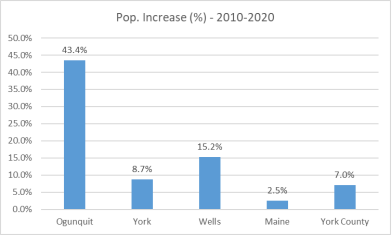
Population Projections
| Population Projections, 2025-2040 | ||||||
| Ogunquit | York | Wells | Maine | York County | ||
| Population projected | 2025 | 1,630 | 14,376 | 11,697 | 1,374,728 | 218,208 |
| 2030 | 1,694 | 15,101 | 12,155 | 1,397,663 | 225,816 | |
| 2035 | 1,745 | 15,715 | 12,515 | 1,407,396 | 231,546 | |
| 2040 | 1,775 | 16,164 | 12,738 | 1,404,176 | 234,689 | |
| Percent change from previous period | 2010- 2015 | 37.6% | 4.1% | 7.5% | – | – |
| 2015- 2020 | 25.3% | 5.3% | 9.5% | – | – | |
| 2020- 2025 | 3.4% | 4.8% | 3.4% | 2.9% | 2.9% | |
| 2025- 2030 | 3.9% | 5.0% | 3.9% | 3.5% | 3.5% | |
| 2030- 2035 | 3.0% | 4.1% | 3.0% | 2.5% | 2.5% | |
| 2035- 2040 | 1.8% | 2.9% | 1.8% | 1.4% | 1.4% | |
| Total Percent Change | 2020- 2040 | 12.6% | 17.8% | 12.6% | 3.1% | 10.7% |
| Source: Maine State Economist, Based on 2020 US Census Population Estimates | ||||||
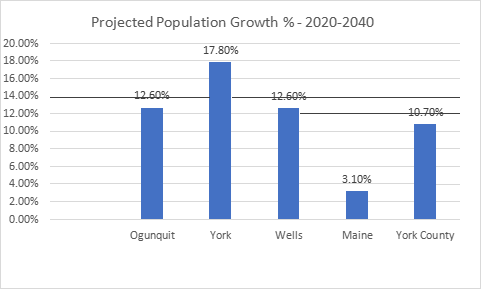
Demographic Conditions
A Word on Demographic Information
Age
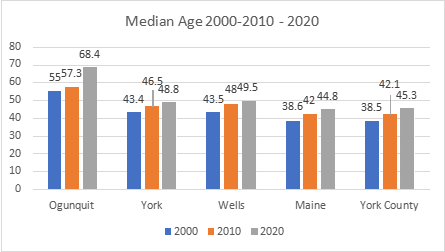
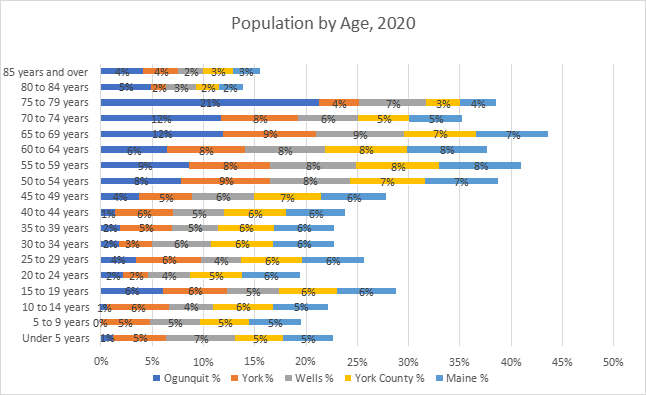
Race
| Population by Race, 2020 (Percent of Total Population) | |||
| Maine | York County | Ogunquit | |
| Total Population | 1,362,359 | 211,972 | 1,577 |
| Population of one race: | 95.3% | 95.0% | 96.9% |
| White alone | 90.8% | 92.1% | 94.4% |
| Black or African American alone | 1.9% | 1.0% | 1.01% |
| American Indian and Alaska Native alone | 0.% | 0.3% | 0.1% |
| Asian alone | 1.20% | 1.2% | 0.6% |
| Native Hawaiian and Other Pacific Islander alone | 0.03% | 0.03% | 0.0% |
| Some Other Race alone | 0.7% | 0.7% | 0.8% |
| Population of two races: | 4.5% | 4.4% | 2.9% |
| White; Black or African American | 0.6% | 0.5% | 0.5% |
| White; American Indian and Alaska Native | 1.% | 1.6% | 0.4% |
| White; Asian | 0.50% | 0.6% | 0.4% |
| White; Native Hawaiian and Other Pacific Islander | 0.03% | 0.03% | 0.0% |
| White; Some Other Race | 1.6% | 1.6% | 1.4% |
| Population of All Other Two or More Races | 0.4% | 0.3% | 3.1% |
| Source: US Decennial Census, 2020 | |||
School Enrollment
School Enrollment, Publicly Funded Students by Residence | |||||||
| Wells-Ogunquit CSD | Other Jurisdictions | |||||
|
Wells |
Ogunquit | Wells- Ogunquit CSD |
Maine | York County |
York | |
2015 | 1,253 | 55 | 1,305 | 182,831 | 27,859 | 1,800 | |
2016 | 1,248 | 49 | 1,295 | 182,007 | 27,712 | 1,760 | |
2017 | 1,264 | 50 | 1,315 | 180,918 | 27,457 | 1,768 | |
2018 | 1,281 | 55 | 1,339 | 180,677 | 27,482 | 1,741 | |
2019 | 1,322 | 51 | 1,376 | 180,817 | 27,424 | 1,691 | |
2020 | 1,339 | 48 | 1,393 | 180,339 | 27,399 | 1,642 | |
2021 | 1,301 | 42 | 1,344 | 172,474 | 26,358 | 1,635 | |
2022 | 1,337 | 47 | 1,386 | 173,237 | 26,339 | 1,586 | |
10 Year Average | 1,299 | 49 | 1,349 | 179,149 | 27,456 | 1,732 | |
2021- 2022 Percent Change |
2.77% |
11.90% |
3.13% |
-0.44% |
-0.07% |
-3.09% |
|
Source: Maine Department of Education, 2023 | |||||||
Educational Attainment
Educational Attainment, Population 25 years and older | |||
| Maine | York County | Ogunquit |
Less than 9th grade | 2.3% | 1.9% | 1.1% |
9th to 12th grade, no diploma | 4.5% | 4.4% | 0.2% |
High school graduate (includes equivalency) | 31.3% | 29.5% | 16.4% |
Some college, no degree | 19.2% | 20.9% | 18.8% |
Associate degree | 10.2% | 11.1% | 7.5% |
Bachelor’s degree | 20.3% | 20.8% | 40.6% |
Graduate or professional degree | 12.2% | 11.% | 15.5% |
High school graduate or higher | 93.2% | 93.8% | 98.7% |
Bachelor’s degree or higher | 32.5% | 32.2% | 56.0% |
Source: American Community Survey 5-Year Estimates, 2015-2020 | |||
Household Size
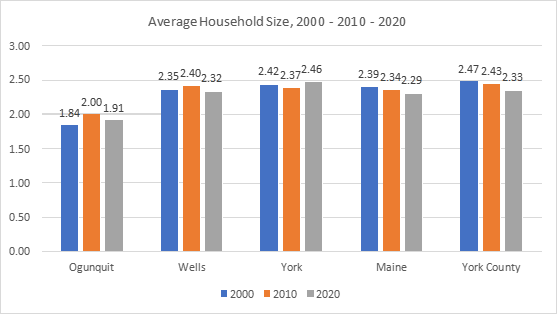
Household Income
| Median Household Income, 2010-2020 | ||
| 2010 | 2020 | |
| Ogunquit | $53,438 | $76,161 |
| Wells | $62,896 | $66,946 |
| York | $75,830 | $97,115 |
| Maine | $55,704 | $59,489 |
| York County | $65,289 | $68,932 |
| Source: ACS 5-Year Estimates, 2010 & 2020 (2010 estimates inflation adjusted to 2020 dollars) | ||
Percent Below Poverty Level, 2020 | |
Ogunquit | 3.8% |
Maine | 11.1% |
York County | 7.4% |
Source: ACS 5-Year Estimates, 2015-2020 | |